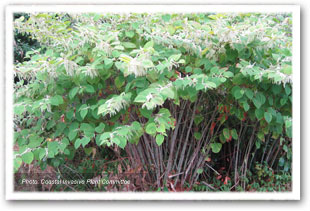Sometimes called ornamental bamboo, invasive knotweed species include Giant knotweed, Japanese knotweed, Himalayan knotweed, and Bohemian knotweed. Invasive knotweeds are widely considered to be the world’s worst invader. They are extremely difficult to control.

Why Control Invasive Knotweeds
Knotweed is capable of growing through concrete, with devastating effects on buildings and other infrastructure. Some financial institutions in the United Kingdom will not grant mortgages on contaminated lands.
Knotweed spreads underground and can reproduce from the tiniest of fragments. In other regions of B.C., knotweed is starting to dominate watercourses, blocking access to valuable recreation areas and altering fish habitat.
Knotweed is only starting to establish in the islands. We have an opportunity to eradicate these species before they gain a foothold in our ecosystems. We need your help.
How You Can Help
Governments and conservation agencies are working to find the most effective way to treat knotweed infestations.
Cutting and mowing can temporarily control top growth but must be repeated numerous times per year for several years before success. Where only a few plants exist, try cutting the stems and manually removing the root masses.
Some regional districts are experimenting with stem herbicide injections, which have been found to be most effective at controlling knotweed.
Contact your regional district to determine which herbicide regulations apply and for information on programs assisting landowners with knotweed.
More Information
Contact your regional district to see if they are assisting landowners remove this highly invasive species.
For more information about invasive knotweeds and current initiatives targeting these species, visit:
- Invasive Knotweed Fact Sheet, Capital Regional District
- Invasive Plants & Alert Information, Comox Valley Regional District
- Invasive Knotweed Regional Reporting System, Capital Regional Invasive Species Partnership
- Giant Knotweed and Japanese Knotweed, Coastal Invasive Plant Committee




